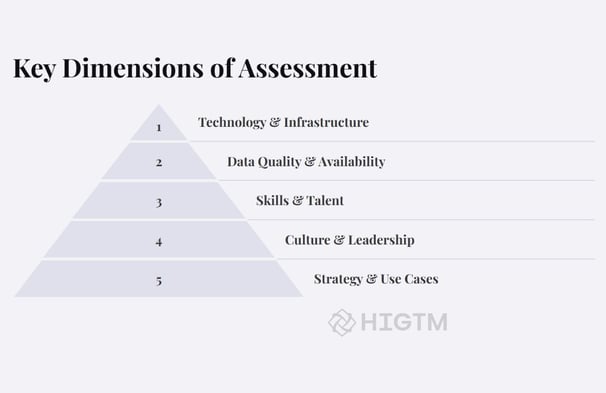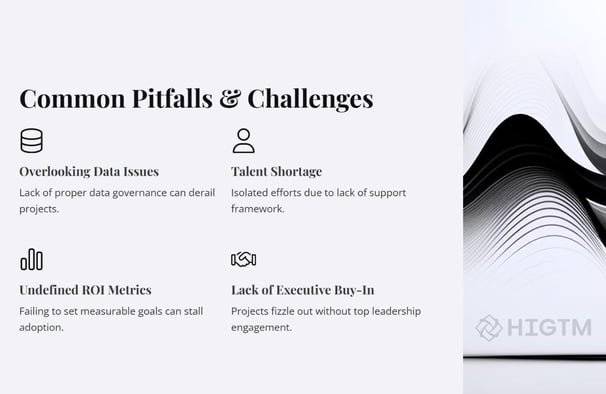17. How to Conduct an AI Readiness Assessment: A Basic Diagnostic Approach for Sustainable Success
Jumping headfirst into AI projects without a solid understanding of your organization’s readiness can lead to wasted resources, low adoption, and a lack of tangible outcomes. This article provides a basic diagnostic approach to conducting an AI Readiness Assessment—a structured way to evaluate whether your technology, data, skills, culture, and strategy are aligned with AI initiatives. Whether you’re a small business owner or an enterprise leader, you’ll gain insights into how to identify strengths, mitigate risks, and set achievable goals for AI adoption.
Q1: FOUNDATIONS OF AI IN SME MANAGEMENT - CHAPTER 1 (DAYS 1–31): CORE AI CONCEPTS & VALUE PROPOSITION
Gary Stoyanov PhD
1/17/20256 min read

1. Understanding AI Readiness
1.1 Why AI Readiness Matters
AI Readiness serves as the foundation for any data-driven transformation. Just as you wouldn’t embark on a road trip without checking your vehicle’s condition, you shouldn’t embark on an AI journey without verifying each critical component of your organization’s engine—technology, data, talent, and culture. Conducting a readiness assessment ensures you’re allocating resources optimally and aligning AI projects with core business objectives.
1.2 Defining “AI Readiness”
AI Readiness is the measure of how prepared an organization is to adopt and benefit from AI initiatives. It encompasses everything from computing infrastructure and data governance to employee skill sets and leadership buy-in. By quantifying this readiness level, companies can tackle obvious gaps before they become bottlenecks.
2. Key Dimensions of an AI Readiness Assessment
2.1 Technology & Infrastructure
Cloud vs. On-Premises: Evaluate whether your hardware and software can support AI’s computational demands.
Security & Compliance: Assess your cybersecurity measures and compliance with relevant regulations (GDPR, HIPAA, etc.).
Integration Capabilities: AI tools often need to connect with ERP systems, CRMs, and other data sources. Confirm these integrations are feasible.
Pro Tip: Even if your current infrastructure is modest, many cloud-based AI services allow you to scale usage on demand, making AI more accessible for SMEs.
2.2 Data Quality & Availability
Data Governance: Who owns the data, and how is it managed?
Data Volume & Variety: AI thrives on diverse datasets—from customer behavior logs to production line metrics.
Data Hygiene: Ensure consistency, completeness, and accuracy. AI models built on flawed data risk producing skewed or useless results.
Pro Tip: Invest in robust data cleaning and data labeling processes before rolling out advanced AI tools. This step can dramatically improve model performance.
2.3 Skills & Talent
In-House Expertise: Data scientists, ML engineers, data analysts, and AI-savvy project managers.
Training & Upskilling: Strategy to fill current skill gaps through internal development or external partnerships.
Collaboration With Consultants: In many cases, SMEs outsource AI tasks to experienced consultants who provide targeted guidance and reduce time-to-value.
Pro Tip: Establish a cross-functional AI task force if you lack a large data science team. This ensures broader organizational perspectives and faster troubleshooting.
2.4 Culture & Leadership
Innovation Mindset: Do employees feel encouraged to experiment, even if it leads to short-term failure?
Executive Sponsorship: AI projects gain momentum when leadership advocates for the long-term vision and provides necessary resources.
Change Management: Comprehensive communication plans and incentives can ease resistance among staff.
Pro Tip: Celebrate small AI wins—like quick pilot successes—to demonstrate value and cultivate an environment that embraces innovation.
2.5 Strategy & Use Cases
Clear Objectives: What business challenges are you trying to solve? Examples might include reducing operational costs, improving customer satisfaction, or accelerating product development.
Use Case Prioritization: Not all AI ideas are created equal. Select the ones with strong ROI or strategic importance first.
KPIs & Milestones: Define how you’ll measure success—whether it’s a specific percentage improvement, a financial target, or time saved on a key process.
Pro Tip: Align AI use cases with immediate operational challenges. This approach demonstrates tangible gains to both employees and leadership, laying the groundwork for bigger projects.
3. Common Pitfalls in AI Adoption
Even well-intentioned AI projects can falter if organizations ignore critical readiness factors:
Data Neglect: Attempting to implement predictive models using incomplete or poor-quality data.
Talent Shortage: Overestimating in-house skills or underestimating the time to hire and train.
Undefined ROI: Launching AI projects without clear success metrics or timelines.
Executive Apathy: Management may approve budgets but fail to provide ongoing oversight or champion new initiatives.
Cultural Resistance: Employees view AI as a threat rather than a tool to elevate their work.
4. A Step-by-Step Diagnostic Process
4.1 Initial Survey & Stakeholder Interviews
Begin by gathering qualitative and quantitative data. Conduct interviews or distribute surveys to various departments, from IT and marketing to finance and HR. This stage uncovers differing perceptions about AI readiness, highlighting any gaps between leadership expectations and ground-level realities.
4.2 Data & Infrastructure Review
Collaborate with your IT and data teams (or external consultants) to inventory data sources and infrastructure components. Identify immediate weaknesses—such as legacy systems or siloed databases—that might impede AI integration.
4.3 Skill & Training Gap Analysis
Use employee assessments, certifications, or external audits to evaluate the team’s data literacy and ability to manage AI-related tasks. If the gap is large, plan for targeted training initiatives or consider partnering with consulting firms specialized in AI.
4.4 Use Case Prioritization
List potential AI projects—ranging from automating customer service to predictive maintenance for manufacturing. Rate them based on feasibility, ROI, and alignment with strategic goals. Focus on a small number of high-impact projects first.
4.5 Roadmap & Action Plan
Compile your findings into a strategic document outlining:
Required budget and technology resources
Training or hiring needs
Clear timelines, milestones, and responsibilities
Measurable KPIs for monitoring progress
Share this roadmap across departments to ensure buy-in and collective accountability.
5. Real-World Examples of AI Readiness
5.1 Mid-Sized Retailer
Initial State: Fragmented sales data, outdated POS software, hesitant staff.
Action Steps: Invested in cloud-based analytics and trained store managers on reading sales dashboards.
Outcome: Within six months, the retailer gained a comprehensive view of inventory and improved restocking efficiency by 20%.
5.2 Manufacturing SME
Initial State: Lacked predictive capabilities, relied on reactive maintenance, minimal AI experience.
Action Steps: Completed a readiness assessment, identified key production lines ripe for predictive maintenance, partnered with an AI consultant.
Outcome: Reduced machine downtime by 30%, improved staff morale by offloading repetitive tasks to automated systems.
5.3 Financial Services Startup
Initial State: Tech-savvy but short on senior leadership with data science expertise, some compliance complexities.
Action Steps: Mapped data sources thoroughly, assigned a small team to develop a chatbot MVP for customer inquiries, secured compliance approval early.
Outcome: The MVP chatbot cut customer response times by half, and the startup used these results to attract further investment.
6. Measuring ROI Throughout AI Adoption
Quantifying the success of AI projects is a critical part of readiness. When formulating your roadmap, plan to revisit ROI at each milestone:
Time Savings: Track the reduced hours spent on repetitive tasks.
Cost Reduction: Measure the decrease in errors, waste, or downtime.
Revenue Growth: Determine if AI enhancements lead to an uptick in sales or cross-selling.
Customer Satisfaction: Survey customers to see if AI-driven improvements boost retention or loyalty.
By continuously measuring these metrics, organizations can pivot or refine strategies as needed—ensuring AI remains a value driver rather than a short-lived experiment.
7. Overcoming Psychological Barriers
7.1 Fear of Obsolescence
Employees may worry AI will replace their roles. Successful AI adoption usually focuses on augmentation rather than replacement—empowering staff to make more informed decisions, reduce manual workloads, and enhance customer experiences.
7.2 Leadership Hesitation
Even enthusiastic CEOs can pause if initial AI pilots don’t yield the expected results. Clear, realistic KPIs and transparent communication can help maintain executive support and adjust timelines or methods as lessons emerge.
7.3 Skepticism vs. Hype
Organizations sometimes see AI as an overhyped trend. A readiness assessment helps set realistic goals by mapping solutions to tangible pain points, turning hype into measurable outcomes.
8. Building a Culture for AI Success
AI readiness isn’t purely about technology—culture plays a pivotal role. Encourage cross-functional meetings where marketing, operations, finance, and IT share insights. This breaks down silos, fosters collaboration, and aligns teams on common objectives. Celebrate short-term achievements, and empower employees to participate in the AI journey. This builds momentum and confidence around adopting advanced solutions.
9. Final Thoughts on the AI Readiness Journey
Embarking on an AI project without assessing readiness is akin to running a marathon without training. You might cover some distance initially, but it’s neither sustainable nor efficient. By methodically examining each dimension—technology, data, skills, culture, and strategy—you position your organization for greater odds of success. Remember that readiness is not a static state; as your business evolves, so will your AI needs and capabilities.
Key Reminders:
Comprehensive Assessment: Look beyond tech—include people, processes, and culture.
Phase Your Rollout: Tackle one or two high-impact projects, learn quickly, and scale.
Keep People Engaged: From executives to frontline employees, ensure everyone understands the purpose, progress, and benefits of AI implementations.
Reassess Regularly: Market conditions, technology trends, and workforce dynamics change. Make AI readiness a recurring strategic exercise.
f you’re looking to conduct an AI Readiness Assessment or need personalized guidance at any step of the journey, our team at HIGTM is here to help.
We specialize in aligning AI solutions with real-world business goals—minimizing risks, amplifying ROI, and paving a sustainable path forward.
Get in touch at HIGTM.com for a Private Counseling Session.
We’ll work together to ensure your organization is primed for AI success, leveraging best practices tailored to your unique industry and challenges.




Turn AI into ROI — Win Faster with HIGTM.
Consult with us to discuss how to manage and grow your business operations with AI.
© 2025 HIGTM. All rights reserved.
